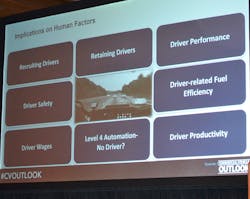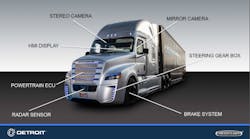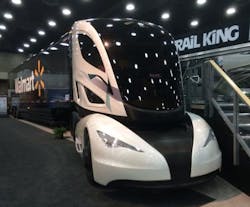Path to autonomous trucks will be a smooth road for drivers
DALLAS. The driver shortage is driving a serious look at self-driving trucks, just not in the way many people assume.
Despite persistent rumors of the demise of the long-haul truck driver in the coming age of automated transport, that time is decades away—and many of the advances between now and then will, in fact, make driving a much more desirable job. That's the takeaway from a panel featuring top industry engineers and analysts at the Commercial Vehicle Outlook conference here.
“People are very interested in automation,” said panel moderator Paul Menig, a technology consultant who previously led the safety systems division at Daimler Trucks and currently co-chairs the Future Truck/Far Horizon effort of trucking’s Technology and Maintenance Council. He cited a Seattle area survey that that confirmed the assertion, with a caveat: “They’re also scared as heck about actually [using autonomous vehicles]. They have to overcome the fear.”
Paradoxically, “the human factor” will be a critical element as trucks become smarter and smarter.
“We’ve done a lot of end-user research to come to the conclusion that autonomous vehicles will enable recruiting drivers,” said Sandeep Kar, global vice president for Frost & Sullivan and an expert in heavy truck systems and technologies. “[Trucking] will need to entice young drivers by giving them a work environment that is less stressful, less disenfranchised—that enables them to connect to the world outside. They want to be connected to their friends, to Facebook or whatever it is: You have to give them some time during their work cycle where they relax, sit back and watch their iPad.”
Currently, just 11% of the truck driver workforce in the U.S. is under 30 years old, Kar noted.
“This is a huge red flag,” he said. “If we want to bet on the U.S. economy, we have to attract young drivers. On the other side, the health, wellness, and well being of the aging drivers is becoming a major driver retention factor.”
As a result, truck makers are more focused than ever on “inside the cab,” based on the growth of investment on things like seating systems, visibility, steering, and the driver interface.
“It’s not by accident that we’re here to talk about automated mobility—it is by design, it is by reality,” Kar said.
Autonomous truck technology, he continued, will enhance driver performance: improved fuel efficiency, improved safety, improved compliance.
The catch, however, is that fleets will question the need to invest in the suite of technologies needed to achieve Level 3 autonomy (a truck that has the ability to take over the driving in certain situations, typically long highway stretches) if they also still have to pay drivers. But the substantial benefits to the supply chain and trucking operations that connectivity and big data will provide should mitigate those concerns.
Level 4 automation means no driver in the cab, and it’s “way out there,” Kar noted, pointing to a Frost & Sullivan market analysis that projects none of these trucks will be on the roads of North America in 2025, and just 300 or so in 2035. And the projection for Level 3 technology is only 3,160 trucks, although that total surges to almost 41,000 by 2035.
But the substantial market growth comes with Level 2 autonomy, or combined technologies that relieve the driver of control of each, which will hit 109,000 trucks in North America in 2025, and more than 200,000 in 2035.
“Long haul is the holy grail for any technology and, coincidentally, augmented driving applies the most in the long-haul truck market,” Kar said.
“I’m not saying driverless trucks when they come in 2035 are going to take over the world,” Kar said. “But be prepared for a future where some trucking vocations will not require drivers.”
He puts the current cost of a suite of the technologies at $20,000, but that cost will go down over the next 10 years with wider adoption. However, the cost of the development of proprietary algorithms and the IT needed to support and secure them will become greater.
Kar concluded with his expert overview of “the future truck.”
“The future truck is going to be a green truck: it will save fuel and have a smaller environmental footprint,” he said. “The future truck will be a safe truck. It will save the life of the driver and people around them. It will be a connected truck, connected to the world outside and world outside will be connected to this truck.
“When you add these three together, it’s safe to assume the future truck will be a smart truck. The question that it begs is: Are we smart enough to embrace the future?”
Safety Inspiration
Some might say the future is here: As Daimler Trucks North America announced in the spring, the Level 3 autonomous Freightliner Inspiration truck is already licensed to operate on the highways of Nevada.
“Taking the long view, Daimler’s vision for safety is the road to accident free driving,” said Derek Rotz, a manager in advanced engineering at DTNA.
And the math is clear: If humans cause approximately 94% of vehicle fatalities, the future for safety lay in taking automated driving “to the next level,” Rotz explained.
“It’s meant to support the driver role, not replace it,” Rotz said. “The system alleviates the driver from the mundane tasks of on-highway driving. It does not substitute the other roles and responsibilities the drive has.”Many of the systems on the Inspiration truck are already available and in production ready, he noted. The key will be “full vehicle integration,” or harmonizing all driving operations. Therefore, the traditional a la carte approach, or picking and choosing from among various component systems, will need to be reconsidered with an eye toward using all the pieces working together.
And that’s where the future performance improvements will come from: A “central decision maker logic” will collect the data from the systems and “assess the situation” to make operational decisions.
“But the technology is really one piece of making automated driving a reality. It really requires all hands on deck: the industry, regulators, legal aspects, and infrastructure,” Rotz said. In other words, “standards—consistent national and arguably global standards.”
Along with uniform regulations and licensing requirements, this includes standardization of the “human-vehicle interface,” or similar set-ups from each truck maker and with each model.
Pete clean sheet
Peterbilt, as with other truck makers, directs a great deal of R&D effort to carving out even the most incremental gains in truck efficiency—but customers still want and expect more.
“We are out there beating the bushes every day to get a 1-2% improvement in fuel economy,” said Kahn, who leads the demonstration vehicle effort that puts theories to the road test, and then makes the call as to whether the gains are worth the cost. And that’s not only price: Any new equipment or modification must be compatible with the “whole-vehicle architecture.”
But when Wal-Mart approached Peterbilt about a developing a truck from “a clean sheet of paper,” the Walmart Advanced Vehicle Experience was born. The concept features leading edge aerodynamics, an advanced turbine-powered range extending series hybrid powertrain, electrified auxiliary components, and sophisticated control systems all in one package.The resulting shape provides a 20% aerodynamic improvement, which by itself results in a 10% improvement in fuel economy, Kahn explained. But, more importantly, Peterbilt’s work of late is focused on its advanced driver assist systems (ADAS), including Level 2 autonomous development. A combination of coming systems should be able to reduce by 80% the amount of “active steering” required of the driver.
“The technologies are not that hard,” Kahn said, “It’s going to be customer acceptance and government regulations.”
He noted that sensor prices will need to come down—likely to be driven by mass production for the automotive market—before a production truck can made “fully situationally aware,” for example.
Teamwork
Platooning is an emerging technology that works well with humans at the wheel and could provide even greater fuel efficiency with automated driving.
Silicon Valley-based base Peloton Technology is leading the development of platooning, which allows a lead truck to virtually take control of a following truck’s acceleration and braking so the pair can travel together much more closely at highway speeds.
With 16,000 highway test miles in the books, the challenge has been to find the sweet spot between the system’s capabilities and what drivers are comfortable with, explained Peloton CEO Josh Switkes.Based on the research results so far, that’s about 40 feet, or more than four times what the technology can do. But when the trailing truck is only 10 feet away from the lead truck, the driver doesn’t see the road and is uncomfortable, Switkes explained.
At 20 feet, “it starts to get comfortable,” and by 40 feet drivers report that it wasn’t as close as they expected, he added.
“A lot of people hear 40 feet and they think you’re staring at a wall, but if you ride in the trucks you’ll see it’s not like that,” Switkes said. “There is a truck in front, but you can see off to the side just fine.”
Again, the human factor is critical. Stay tuned.
About the Author
Kevin Jones 1
Editor
Kevin has served as editor-in-chief of Trailer/Body Builders magazine since 2017—just the third editor in the magazine’s 60 years. He is also editorial director for Endeavor Business Media’s Commercial Vehicle group, which includes FleetOwner, Bulk Transporter, Refrigerated Transporter, American Trucker, and Fleet Maintenance magazines and websites.





